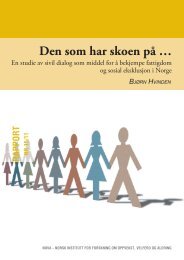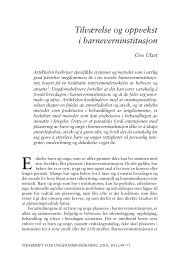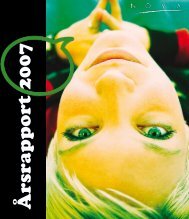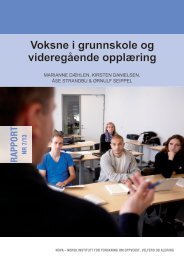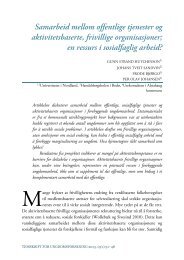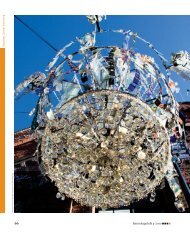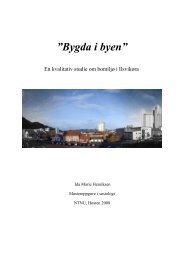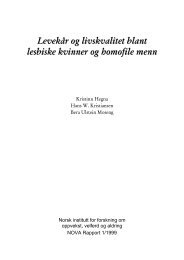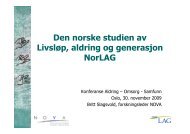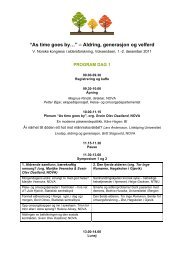Betydningen av seksuell erfaring, tiltrekning og identitet for ...
Betydningen av seksuell erfaring, tiltrekning og identitet for ...
Betydningen av seksuell erfaring, tiltrekning og identitet for ...
You also want an ePaper? Increase the reach of your titles
YUMPU automatically turns print PDFs into web optimized ePapers that Google loves.
among the young women in the present study, it seems reasonable to<br />
conclude that the risk <strong>for</strong> frequent intoxication and drug use may be higher<br />
among young bisexual women or young women with a homosexual<br />
orientation. Young men with homosexual attractions reported strong<br />
feelings of loneliness and low peer acceptance compared to young men with<br />
heterosexual or solely homosexual experience, and also compared to young<br />
women reporting homosexual attractions. This may suggest that the<br />
stigmatisation is indeed stronger <strong>for</strong> gay men, but that other mechanisms<br />
than stigmatisation and social isolation lie behind the risk <strong>for</strong> frequent<br />
intoxication and drug use among young homosexually attracted women<br />
contrary to what was suggested in the studies referred earlier (Caldwell et<br />
al., 1998; Faulkner & Cranston, 1998; Fergusson et al., 1999; Garofalo et al.,<br />
1999; Smith et al., 1999).<br />
Although the current study is based on a nationally representative<br />
sample and good response rates, there may however be certain limitations.<br />
Sexual beh<strong>av</strong>iour in general and homosexual beh<strong>av</strong>iour in particular, as well<br />
as substance use and poor social networks may be sensitive topics even<br />
when self-administered and anonymous questionnaires are used. It is<br />
there<strong>for</strong>e likely that these topics to some extent h<strong>av</strong>e been under-reported. In<br />
the case of systematic under-reporting on all these topics, we may expect<br />
that the observed associations are biased downwards. On the other hand, it is<br />
also possible that to some extent we may be dealing with so-called ‘false<br />
positives’, <strong>for</strong> example, that students h<strong>av</strong>e reported illicit substance use<br />
without really h<strong>av</strong>ing this experience. In particular this may be a problem<br />
when we are dealing with low-incident or low-prevalent phenomena, such as<br />
illicit drug use or homosexual beh<strong>av</strong>iour (see <strong>for</strong> instance Sk<strong>og</strong>, 1992). Even<br />
if only a very small proportion of the respondents h<strong>av</strong>e systematically overreported<br />
on low-prevalent topics, the observed associations may be biased<br />
upwards. Hence, both under-reporting and over-reporting may h<strong>av</strong>e<br />
occurred. For this reason, it is not clear whether the results may be biased to<br />
some extent, and if so in which direction. In addition, the time frame <strong>for</strong> the<br />
questions on homosexual experience and attractions (during teenage years),<br />
substance use (previous 12 months) and social networks and loneliness<br />
(present) varies, and the data are cross sectional. The interpretation of the<br />
associations between these measures is thus restricted to an inference of<br />
group differences.<br />
176<br />
– NOVA Rapport 1/07 –




